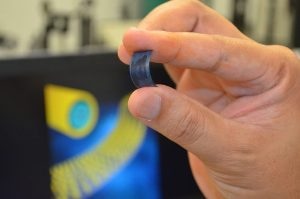Nov 22 2016
Scientists at the NanoScience Technology Center of University of Central Florida (UCF) have developed a novel method for producing flexible supercapacitors that can store more amount of energy and can be recharged over 30,000 times without any sign of degradation. This new process could transform technology such as electric vehicles and mobile phones in the future.
 A thin, flexible supercapacitor developed at the University of Central Florida boasts high energy and power densities. (Photo courtesy of University of Central Florida)
A thin, flexible supercapacitor developed at the University of Central Florida boasts high energy and power densities. (Photo courtesy of University of Central Florida)
If they were to replace the batteries with these supercapacitors, you could charge your mobile phone in a few seconds and you wouldn’t need to charge it again for over a week.
Nitin Choudhary, a postdoctoral associate, main researcher of the study
The results of the study have been reported in the academic journal, ACS Nano.
Smartphone users are aware of the problem: After a period of 18 months or so, the charge capacity of the smartphone continues to diminish as the battery starts to degrade.
Researchers have been exploring the use of nanomaterials to enhance supercapacitors that could not only improve, but also substitute the batteries in electronic devices. However, this is a challenging problem, since a supercapacitor that stores as much energy as a lithium-ion battery would need to be much larger.
The UCF team has attempted to apply newly discovered 2D materials that measure just a few atoms thick to supercapacitors. Other scientists have also tried formulations with other 2D materials including grapheme, but had only limited success.
There have been problems in the way people incorporate these two-dimensional materials into the existing systems – that’s been a bottleneck in the field. We developed a simple chemical synthesis approach so we can very nicely integrate the existing materials with the two-dimensional materials.
Yeonwoong “Eric” Jung, assistant professor, principal investigator of the study
Jung’s team was able to produce supercapacitors that contained millions of nanometer-thick wires coated with shells of 2D materials. A highly conductive core enables rapid transfer of electrons for quick charging and discharging cycles, and shells of 2D materials that were uniformly coated yield high energy and power densities.
Jung explained that researchers are well aware of the fact that 2D materials provide new opportunities for energy storage applications. However, there was no way to realize that potential until the UCF team developed the process to integrate those materials.
“For small electronic devices, our materials are surpassing the conventional ones worldwide in terms of energy density, power density and cyclic stability,” Choudhary said.
Cyclic stability refers to the number of times it can be charged, drained, and recharged before it begins to degrade. For instance, it is possible to recharge a lithium-ion battery fewer than 1,500 times without any considerable failure. New formulations of supercapacitors that use 2D materials can be recharged several thousand times. In contrast, the UCF-developed process creates a supercapacitor, which even after 30,000 times of recharge, does not degrade.
To patent the novel process, Jung has collaborated with UCF’s Office of Technology Transfer
Supercapacitors using the novel materials can potentially be used in electric vehicles, phones, and other similar electronic gadgets that can benefit from sudden bursts of speed and power. Since supercapacitors are flexible, it could mean a key development in wearable technologies as well.
It’s not ready for commercialization. But this is a proof-of-concept demonstration, and our studies show there are very high impacts for many technologies.
Yeonwoong “Eric” Jung, assistant professor, principal investigator of the study
Apart from Jung and Choudhary, the research team included Julian Moore, Chao Li, and Associate Professor Jayan Thomas, all from the UCF NanoScience Technology Center; and Hee-Suk Chung of Korea Basic Science Institute in Jeonju, South Korea.